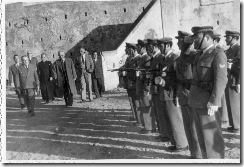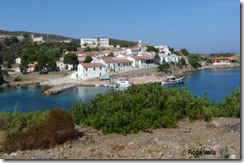Posts Tagged ‘Barbarossa’
-
AND THEY ALL CAME TO SEA
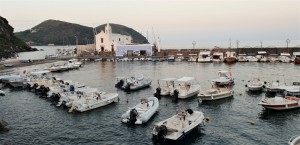 At the centre of the attractive small harbour of Marina Corta in Lipari, there is an unassuming quaint church dedicated to Our Lady of the Snow and to the Souls of Purgatory. One could easily fail to visit this place since fun and life beckons from the several restaurants, cafeterias and shops situated right across in the spacious square. Yet a most unique and pleasant surprise awaits those who decide to step inside.
At the centre of the attractive small harbour of Marina Corta in Lipari, there is an unassuming quaint church dedicated to Our Lady of the Snow and to the Souls of Purgatory. One could easily fail to visit this place since fun and life beckons from the several restaurants, cafeterias and shops situated right across in the spacious square. Yet a most unique and pleasant surprise awaits those who decide to step inside.The church was built in 1545, just five years after the island of Lipari was sacked by the Turkish corsair Barbarossa who took away almost the entire population into slavery. Defiantly constructed on the jutting rocks, the church intended to serve as a point of reference for those who repopulated the island.
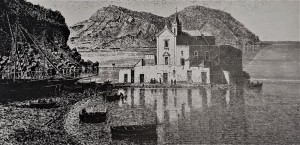 However, along the years, as other chapels and churches were built around Lipari, this church was abandoned and left to its own destiny. Critically close to the sea, the building suffered severe damage, and in recent years, it was on the brink of collapse.
However, along the years, as other chapels and churches were built around Lipari, this church was abandoned and left to its own destiny. Critically close to the sea, the building suffered severe damage, and in recent years, it was on the brink of collapse.On a cold winter day in 2011, with the rough seas hitting mercilessly at this church, a group of locals decided to save this place. They were all saddened by the neglected state of this historical building and they were adamant to do something about it. After they came out with a plan, they discussed their ideas with their parish priest, Fr Giuseppe Mirabito, who agreed at once to collaborate with them.
The Association SS. Cosma and Damiano Marinacorta was established to coordinate this project. The stability of the building was the first thing which had to be addressed quickly. As the members of the association talked about this project with other locals and friends, support came in the form of the required materials and voluntary help. In time, the external part of the church was restored. However, the internal area of the church remained in dire need of restoration.
 As the building started to regain its dignity, the association’s members needed to come up with new ideas to attract visitors to the church. Their main aim was to create more awareness about the historical and cultural value of this building so that more people would help out with this venture, particularly with the funds which were required to restore the church completely.
As the building started to regain its dignity, the association’s members needed to come up with new ideas to attract visitors to the church. Their main aim was to create more awareness about the historical and cultural value of this building so that more people would help out with this venture, particularly with the funds which were required to restore the church completely.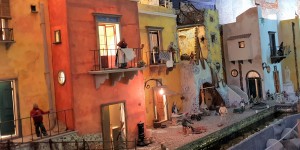 Since it was close to Christmas, they decided to build a crib inside the church. But this was no ordinary crib with religious iconography. Instead, it was laid out to represent the fishing village of Lipari as it was in the old days and it was named Presepe del Mare.
Since it was close to Christmas, they decided to build a crib inside the church. But this was no ordinary crib with religious iconography. Instead, it was laid out to represent the fishing village of Lipari as it was in the old days and it was named Presepe del Mare.Peppuccio Costanzo, one of the association’s members and a fisherman, assisted in the design of this crib which was made of papier-mache. The miniature village was a replica of the real buildings, architecture and life that existed in Lipari around fifty years ago. A number of known village characters were also included in this most unusual crib.
 The crib’s landscape was built along a watercourse with real fish living inside. The crib is mostly populated by fishermen, some of whom are at work while others are idling around. The attention which was given to the details in this crib acts as a time capsule to help visitors visualize better how Lipari looked before it was regenerated to suit the needs of the increasing tourist demands. It also pictures several traditions of the time. Locals may even recognize some of the people represented in the figurines; a number of whom have by now passed away.
The crib’s landscape was built along a watercourse with real fish living inside. The crib is mostly populated by fishermen, some of whom are at work while others are idling around. The attention which was given to the details in this crib acts as a time capsule to help visitors visualize better how Lipari looked before it was regenerated to suit the needs of the increasing tourist demands. It also pictures several traditions of the time. Locals may even recognize some of the people represented in the figurines; a number of whom have by now passed away.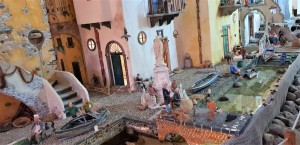 Existing landmarks such as the church of St Joseph and the statue of St Bartholomew serve as identifying marks in the changing village. Gone are most of the old houses which can be seen in the crib. Today, these have been replaced by higher modern buildings. Traditional life as shown in the crib has almost dissolved into nothingness. Tradesmen’s shops have been taken over by modern outlets selling souvenirs or boat rides. The fish seller who called out in the streets, nowadays displays his fish in a van. Women do not carry water jugs anymore; tap water is now readily available. Clothes are no longer washed in public places; washing machines take care of this matter. The young man who played the guitar beneath the balcony of the girl he loved will today send her an sms instead.
Existing landmarks such as the church of St Joseph and the statue of St Bartholomew serve as identifying marks in the changing village. Gone are most of the old houses which can be seen in the crib. Today, these have been replaced by higher modern buildings. Traditional life as shown in the crib has almost dissolved into nothingness. Tradesmen’s shops have been taken over by modern outlets selling souvenirs or boat rides. The fish seller who called out in the streets, nowadays displays his fish in a van. Women do not carry water jugs anymore; tap water is now readily available. Clothes are no longer washed in public places; washing machines take care of this matter. The young man who played the guitar beneath the balcony of the girl he loved will today send her an sms instead. The crib’s culmination and originality is certainly in the warm and simple nativity scene where fishermen are greeting baby Jesus, not sheperds. Colourful fishing boats and straw fishermen’s baskets are present in the area, not hills and sheep. An angel sings besides a balcony of a house not on top of a cave.
The crib’s culmination and originality is certainly in the warm and simple nativity scene where fishermen are greeting baby Jesus, not sheperds. Colourful fishing boats and straw fishermen’s baskets are present in the area, not hills and sheep. An angel sings besides a balcony of a house not on top of a cave.As people came to visit this crib, it became evident that this was more than a seasonal project. Soon it was decided that this crib should remain in this church as a cultural symbol of Lipari. The crib would be visitable all around the year and whoever paid the entrance fee of €1 would be assisting in the restoration of the church.
 By now, Presepe del Mare has come to form part of the cultural identity of Lipari. Besides presenting the craftsmanship of those who made it, the crib is also a relevant reminder of the importance of keeping traditions alive and of conserving the remaining architecture of the area.
By now, Presepe del Mare has come to form part of the cultural identity of Lipari. Besides presenting the craftsmanship of those who made it, the crib is also a relevant reminder of the importance of keeping traditions alive and of conserving the remaining architecture of the area.Info about Lipari: The island of Lipari is the largest of the Aeolian volcanic archipelago. Nowadays, its population is around 12,700, although it generally reaches 20,000 during the tourist season, from May to September. Due to its charming character, historical value and holiday atmosphere, Lipari is a top destination. Fast ferry connections from Sicily all stop at this island, as well as plenty of boats and hydrofoils, making it the ideal place to reach the other islands in the archipelago – Vulcano, Salina, Stromboli, Filicudi, Alicudi, Panarea and Basiluzzo.
(This feature was published in The Christmas Supplement issued with The Sunday Times of Malta on 2nd December 2018)
-
Sardinia’s Alcatraz
There are certain places which are hard to forget since somehow they leave a distinguished imprint on one’s memory. One of these is the island of Asinara which forms part of the territory of Sardinia in Italy. Renowned for its Albino indigenous donkeys from which the name of the island is said to have originated, this particular land is also notorious for its melancholic fate, since it has often been used as a place of seclusion, and was even turned into a penitentiary institution during its last inhabited years. Recently Asinara has been declared as a protected natural reserve and one can only visit it in the company of a licensed guide. Without any more human intervention, the island seems to be turning back to its ancient origins as nature is reclaiming back its rudimental landscape. Tourists who visit the island claim that now this zone has become a delightful gem and yet a previous inhabitant of Asinara questions whether in reality the island has been simply abandoned and left to deal with its own destiny. Surely, a visit to this island will not leave anyone untouched.
Asinara is located off the north-western tip of Sardinia. Its territory is about 52 km2 and it belongs to the government. The island of Asinara can be reached by a boat from the nearby coastal village of Stintino which is located in the province of Sassari. Guided tours can take you to visit the island through a selection of means which include bicycles, landrovers, touristic trains, kayaks and boats. Considering the heat and the fact that we were going to spend almost a day on the island, we opted for the comfortable and colourful tourist train that was scheduled to take us to the most prominent areas of the island.
The island’s vegetation and climate are typically Mediterranean but on some rocky coastal areas, one can also identify an endemic plant species of Sardinia known as Fiordaliso Spinoso. Asinara is also famous for its native Albino donkeys, most of which are regularly observed roaming freely around the island and feeding on shrubs. Yet here visitors can also have a glimpse at the typical Sardinian donkey which is generally smaller and has a brownish colour with a black stripe on its back. Other fauna includes wild pigs, sheep, goats and horses; the latter having been liberated on the island by Asinara’s prison guards once the penitentiary institutions were closed down.
Traces of human habitation on Asinara go back to prehistoric times as the site of Campu Perdu confirms. Moreover, due to its strategic central position in the Mediterranean, the island has formed part of the history of the Phoenicians, the Greeks and the Romans. Asinara was also habitually frequented by pirates, and a legend narrates that the granite castle which to date dominates the highest point of the island, had served for some time as the residence of the famous Barbarossa. In the 17th century, the island was inhabited by shepherds. However in the 19th century the island became government property and on this land, it was decided to construct a lazaretto for victims of contagious diseases. Soon after, Asinara was also selected as a place of exile for a number of prisoners. Eventually, these arrangements led the shepherds to leave the island and most of them formed the nearby village of Stintino on the mainland.
During World War 1 Asinara was turned into a prison for about 24,000 Austrian and Hungarian soldiers; 5000 of which died on the island. Then, some years later, during the 1970s, the prisons on the island were restructured to become high-security prisons in order to detain within them some of the most dangerous criminals, such as those that formed part of the Brigate Rosse, terrorists, and mafia members; the most infamous of which being Totò Riina. It was on this island too that the magistrates Giovanni Falcone and Paolo Borsellino had resided as part of the security measures that were taken during the prominent trials that were taking place during that period. Finally, in 1997, Asinara was declared as a protected nature reserve and nobody else, except the few guardians who take care of the island, were allowed to live there.
A tour around the island will reveal several of the constructions that have once served various functions during Asinara’s history. Some structures have been completely abandoned and are in ruins, whilst others such as the high-security prisons, have been restored as tourist attractions. In these prisons, visitors can experience the conditions in which the prisoners used to live wherein they were always under the supervision of the prison guards. A chamber where the prisoners could take a break from their cells was securely covered by a thick metal net. However this served to provide a view of the beautiful blue sky which though it could have offered some sort of relief, at the same time it probably increased the painful realization of living on such an idyllic island and yet being confined within those punitive walls. In the meantime, although these prisons have been unused for some years now, visitors can’t help reacting when they enter into Totò Riina’s cell. A similar strong emotion is felt on entering the building of the old prison of Fornelli wherein one can also visit the high-security cells whilst also view some old photos of a number of ‘trusted’ prisoners which used to be allowed to work in the fields and to take care of the animals on the island under the guards’ surveillance. Eventually, visitors were also led to Cala d’Oliva; the small village where Asinara’s workers used to reside.
Indeed, 92 year old Franca Fadda Silvetti still remembers the time when she used to live at Cala d’Oliva with her family on Asinara. In her autobiographical book ‘La mia Asinara: ricordi di una maestra’, she describes her 33 years residing on this island where her husband Vindice had been appointed as the prisons’ doctor and where she worked as a primary school teacher of the other workers’ young children. Interestingly, Franca has many positive memories of Asinara even though it was a penitentiary island. When I asked her whether she ever felt afraid or in danger on such a remote place inhabited by prisoners, she adamantly insisted that this was never the case. To make her point, she confirmed that some reliable prisoners were allowed to work outside the prisons during daytime and one of them used to take care of her house and to baby-sit with her young children while she was at work! Now that Franca is widowed, her nostalgic memories of the island’s beautiful environment are even stronger and yet she has never found the courage to return to Asinara from the day when all the island’s inhabitants were ordered to leave the place. Franca wonders whether the decision to leave the island in a state of abandonment was better than having allowed it to remain inhabited by a ‘strange’ population as it was back in 1952 when she put her first steps on that land which had remained so dear to her. She conceded that she decided to write her book in memory of the delightful moments that she and her family have enjoyed on the island so that even today’s readers could get a glimpse of how Asinara used to be.
Certainly those who visit Asinara will also get the opportunity to swim in the crystal clear blue sea of three particular beaches which have been selected for the use of tourists. Impressively, various sizeable fish swim confidently among the visitors as if aware that they are protected in this nature reserve. In the background, from time to time, the magnificent silence on the island is pierced by the shrill neighing of Asinara’s donkeys.
Once the visit is over and the rented boat takes you away from Asinara, you can easily feel Franca’s nostalgia for this land which can overwhelm you with different sensations. Should you desire a longer stay on this peculiar sanctuary, there is a small restaurant and a basic hostel.
(An edited version of this article was published in the Travel Section of the Times of Malta dated 6th October 2013)
Travelogue
Archives
| M | T | W | T | F | S | S |
|---|---|---|---|---|---|---|
| « Jan | ||||||
| 1 | 2 | 3 | 4 | 5 | 6 | 7 |
| 8 | 9 | 10 | 11 | 12 | 13 | 14 |
| 15 | 16 | 17 | 18 | 19 | 20 | 21 |
| 22 | 23 | 24 | 25 | 26 | 27 | 28 |
| 29 | 30 | 31 | ||||
Recent Posts
- A MATTER OF FATE
- MALTA’S PREHISTORIC TREASURES
- THE MAGIC IS IN THE DETAIL
- THE SELLING GAME
- NEVER FORGOTTEN
- Ġrajjiet mhux mitmuma – 35 sena mit-Traġedja tal-Patrol Boat C23
- AN UNEXPECTED VISIT
- THE SISTERS OF THE CRIB
Comments
- Pauline Harkins on Novella – Li kieku stajt!
- admin on IL-KARNIVAL TRAĠIKU TAL-1823
- Albert on IL-KARNIVAL TRAĠIKU TAL-1823
- Martin Ratcliffe on Love in the time of war
- admin on 24 SENA ILU: IT-TRAĠEDJA TAL-PATROL BOAT C23

